In this edition:
* ROBUSTA-3A in Orbit
* SONATE-2 APRS Digipeater in Operation
* Wireless Technology Workshop in India
* Small Satellites of the Future Grow Larger
* ASRTU-1 Scheduled for November Launch
* Changes to AMSAT-NA TLE Distribution
* ARISS News
* Upcoming Satellite Operations
* AMSAT Ambassador Activities
* Satellite Shorts From All Over
The AMSAT News Service bulletins are a free, weekly news and information service of AMSAT, the Radio Amateur Satellite Corporation. ANS publishes news related to Amateur Radio in Space including reports on the activities of a worldwide group of Amateur Radio operators who share an active interest in designing, building, launching and communicating through analog and digital Amateur Radio satellites.
The news feed on http://www.amsat.org publishes news of Amateur Radio in Space as soon as our volunteers can post it.
Please send any amateur satellite news or reports to: ans-editor [at] amsat.org
You can sign up for free e-mail delivery of the AMSAT News Service Bulletins via the ANS List; to join this list see: https://mailman.amsat.org/postorius/lists/ans.amsat.org/
ANS-217 AMSAT News Service Weekly Bulletins
To: All RADIO AMATEURS
From: Radio Amateur Satellite Corporation
712 H Street NE, Suite 1653
Washington, DC 20002
DATE 2024 Aug 4
ROBUSTA-3A in Orbit
When the long-delayed inaugural launch of the European Space Agency’s (ESA’s) new Ariane 6 rocket finally occurred on July 7, it suffered an upper stage failure that left some payloads in the wrong orbits. Fortunately, before the anomaly developed, the Ariane 6 successfully deployed ROBUSTA-3A, a satellite with an amateur radio payload. The target was a 580 km circular orbit with an inclination of 96 degrees.
ROBUSTA-3A (a.k.a. “Méditerranée”) is a 3U cubesat, designed and built by students and faculty of Université de Montpellier in southern France. Over a decade in development, involving around 300 students from the University of Montpellier and all over the world, ROBUSTA-3A will be its seventh satellite developed entirely in-house, having learned much from the development and launch of smaller ROBUSTA-1U satellites. The project has offered hands-on training, engineering and scientific experience to the next generation of space engineers and researchers.
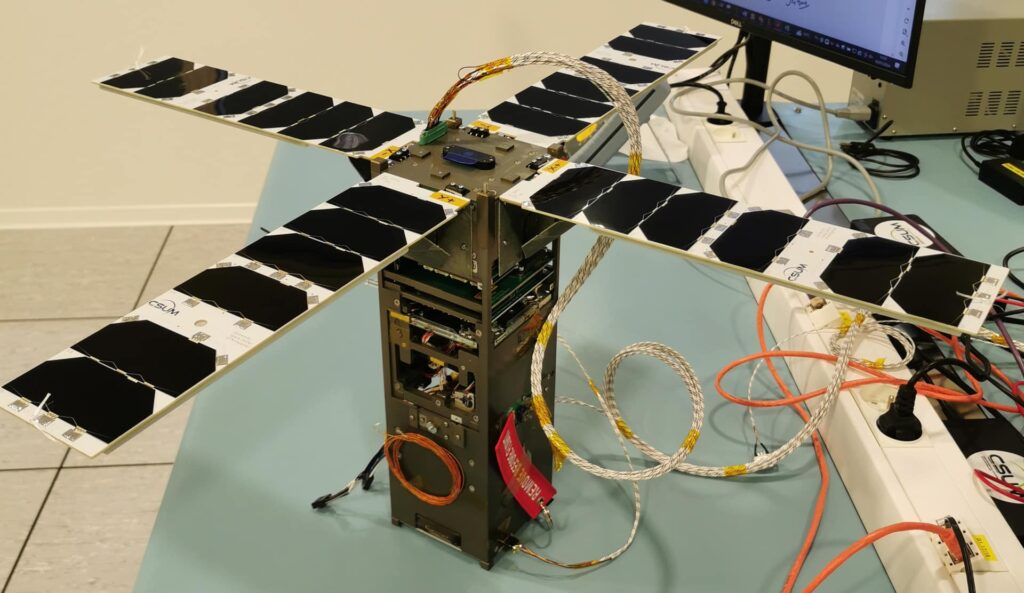
The Robusta 3A satellite is 3U, three CubeSat units. (Photo: Van Allen Foundation)
The satellite’s primary mission is weather observation, specifically to track “Cevenol events.” These are intense storms and incredibly heavy rains that cause extensive flooding, often in the form of flash floods, that hit the plains and the foothills of southern France. Once considered “100-year storms,” they have been occurring with greater frequency due to global climate change. Most of the weather data is downlinked on a commercial S-band microwave frequency.
“If the data we will be collecting improves the geographic and temporal accuracy of weather forecasts for cévenol events, it would help authorities give early warning to the population and allow rescue services to better target the areas at risk,” explains Romain Briand, assembly integration and testing manager at the University Space Center of Montpellier.

Robusta-3A under development by Centre Spatial Universitaire de Montpellier (CSUM)
However, ROBUSTA-3A aims to do even more than chart water vapour from space.
The satellite carries an experimental Attitude Determination and Control System (ADCS) that will seek to optimize solar panel exposure and correctly aim sensors and microwave downlink antennas. Using a set of Sun sensors, magnetometers, and reaction wheels in a pyramidal configuration, the system should provide precise attitude control, especially during orbital maneuvers.
The satellite will also employ a cold gas thruster propulsion system which operates with solid iodine as propellant. This system will demonstrate orbit maintenance, phasing, and lifetime extension of small satellite missions, and could also help with end-of-life decommissioning and debris mitigation.
As an extra mission, the CubeSat will test how computer memory from chip manufacturer 3D PLUS withstands the radiation of space. This French company specialises in highly-reliable electronic components and their computer memory recently landed on the Moon as part of the India’s Chandrayaan-3 lander.
Finally, ROBUSTA-3A also carries a 9k6 GMSK AX.25 store-and-forward digital system with a UHF transmitter output of up to three watts — a very powerful downlink! As the satellite is sill in commissioning, operating protocols and uplink frequency have not yet been released. However, amateurs should expect something similar to the FalconSAT-3 store-and-forward system that was popular until that satellite deorbited in January of 2023. ROBUSTA-3A is currently transmitting short telemetry bursts on its International Amateur Radio Union (IARU) coordinated downlink frequency of 436.750 MHz.
[ANS thanks ESA, IARU, and the Space Center of the University of Montpellier for the above information.]
The 2024 AMSAT President’s Club coins are here now!
Help Support GOLF and Fox Plus
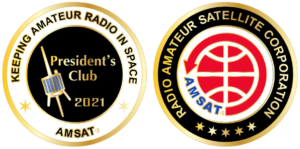
Join the AMSAT President’s Club today and help
Keep Amateur Radio in Space!
https://www.amsat.org/join-the-amsat-presidents-club/
SONATE-2 APRS Digipeater in Operation
Professor Hakan Kayal from Julius-Maximilians-Universität (JMU) Würzburg in Bavaria, Germany posted on X this past week, “Thanks to everyone using SONATE-2’s APRS digipeater over the weekend. A total of 421 messages were digipeated.”
The Bayerische Julius-Maximilians-Universität Würzburg’s SONATE (SOlutus NAno satelliTE) satellite is a technology demonstration mission for highly autonomous payloads and artificial intelligence in the 6U CubeSat class. As part of the SONATE-2 mission, novel hardware and software technologies of artificial intelligence (AI) are to be verified in miniaturized format in earth orbit. By using such AI technologies, the satellite can independently analyze the environment and start autonomous recordings. Deep learning plays a special role as a versatile image processing tool. In addition to the classification of targets already known at the start of the mission, the payload should also have the option of on-board training for the detection of anomalies as previously unknown objects or phenomena.
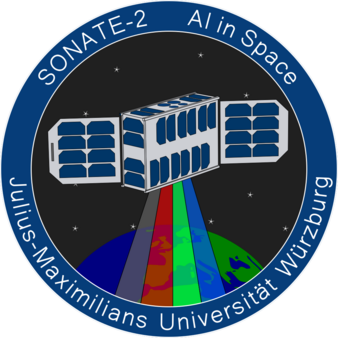
SONATE-2 mission patch (JMU artwork)
The operation of an amateur radio payload is important to the educational mission of SONATE-2. The development and operation of the satellite is used for the education of students of the university. In cooperation with the DLR School Lab in Neustrelitz, Germany, it is planned to use the amateur radio payload for the education of high school students.
The amateur payload of SONATE-2 consists of a VHF transceiver that was already built for the predecessor mission SONATE over the course of several student projects. For SONATE-2 additional student projects extended the transceiver functionalities. It will provide regular SSTV downlinks with images from the optical sensors included in the AI payload as well as an APRS digipeater and CW beacon.
On the education side, the mission will serve as a foundation for different aspects of the university aerospace and computer science engineering program. In the context of practical courses, as thesis authors or as student assistants, students can participate in the development of all subsystems of the space and ground segment, including the amateur radio payload and the technology demonstration payload. In the context of mandatory lectures and exercises on space operations every student will also be included in the operations of the satellite.
The German Aerospace Center (DLR) offers a School Lab for high school students at the location of the external ground station in Neustrelitz, Germany. Besides experiments on space and satellites, the School Lab includes amateur radio contacts to the ISS under the supervision of licensed local radio amateurs, which they wish to extend to other satellites like in this cooperation with the SONATE-2 mission.
Besides the amateur and educational mission parts, the SONATE-2 mission also has a research objective for the demonstration of novel artificial intelligence technology in the space environments. While the AI payload is mainly operated using a separate up/downlink in the space operation service in S-band, the satellite bus and the amateur payloads are operated in the amateur service. Housekeeping telemetry in the amateur service also contains status information of the non-amateur payload.
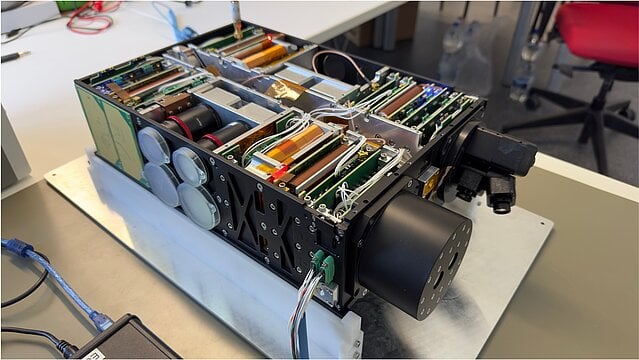
SONATE-2 Test Model, October 2023 (Photo: JMU)
According to Kayal, not many similar projects are currently being undertaken.
“Let’s assume that a small satellite is to investigate a new asteroid in the solar system in the future. It cannot be trained for this task on the ground, because the object of investigation is largely unknown. There is no training data, so the measurements and recordings can’t be made on the ground,” Kayal added.
Transmitting this data to Earth for initial processing and subsequently training the AI via remote control would result in significant time delays for missions located at a considerable distance from Earth.
Opting for a heightened level of autonomy with direct on-board AI support would greatly enhance the mission’s efficiency. This approach would expedite the detection of intriguing objects and phenomena on the asteroid, considerably reducing the time required for their identification.
To facilitate this, four on-board cameras capture the essential imagery required for training the AI. Initially, the AI acquires knowledge of conventional geometric patterns on Earth’s surface, among other things, which subsequently empowers it to autonomously identify anomalies.
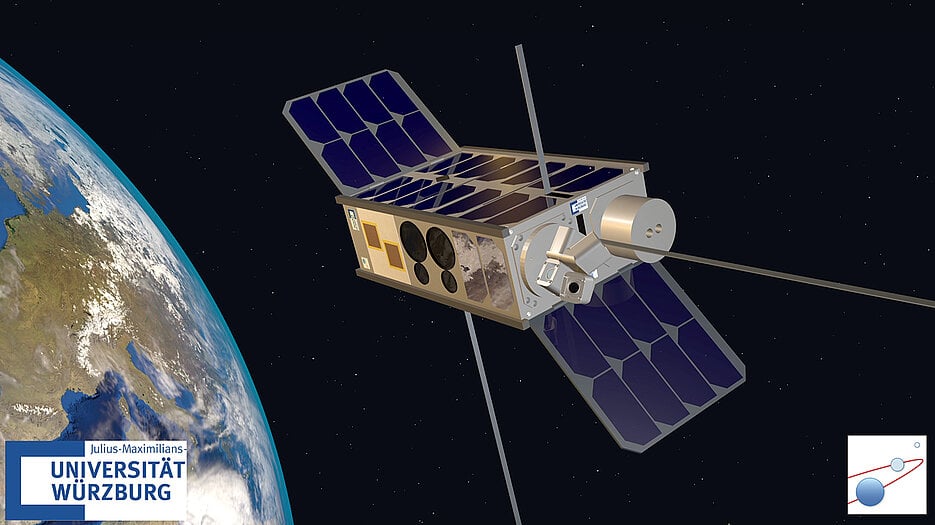
A model of the SONATE-2 nanosatellite, here artistically depicted in orbit. (Image: Hakan Kayal / Universität Würzburg)
In addition to these AI experiments, SONATE-2 carries a suite of other small satellite technologies that are ready for in-orbit testing. These technologies include an automated lightning detection and recording system, as well as an electric propulsion system developed in collaboration with the University of Stuttgart.
Kayal added, “In terms of complexity, SONATE-2 is unparalleled among nanosatellites.”
SONATE-2 was one of a cluster of satellites launched on a SpaceX Falcon-9 flight on March 5, 2024. Digipeater and SSTV activations are announced at https://x.com/JMUSpace/.
SSTV downlink: Regular downlink of images captured by the on-board cameras
Frequency: 145.880 MHz
Modulation: Martin M1 SSTV FM (F3F)
TX Power: 500mW
APRS digipeater: (Updated 26.07.2024)
APRS digipeater in half-duplex operation. Digipeater is only active when published at https://x.com/JMUSpace/. When activated, it will transmit a greeting message every 2 minutes.
Make sure to include SONATE-2 callsign DPØSNX in the APRS route.
Frequency: 145.825 MHz Up/Down
Modulation: 1k2 AFSK (F2D)
Protocol: AX.25
TX Power: 500mW
[ANS thanks JMU Würzburg, Gunter’s Space Page, and AZO Robotics Network for the above information.]
Wireless Technology Workshop in India
A special workshop on ‘Wireless Technology and its Practical Solutions’ was conducted for Rajkot – Police Wireless Department at Gujarat (India) on 20th July 2024. The venue was the Police Training Center at Rajkot Headquarter. It was a highly informative 3 hours session from 10:00 AM to 1:00 PM.
Regional Coordinator of AMSAT-INDIA & The Amateur Radio Society of India, Mr. Rajesh Vagadia, VU2EXP, gave insight into various Radio Communication protocols, types of modulation, modes & various applications used in Amateur Radio & Police department.

Rajesh Vagadia, VU2EXP (hamphotos.com)
As this workshop was targeted for 25 technical wireless officers & radio operators, we focused on the radio communication enhancing methods, utilizing various techniques, using different antennas for specific applications and diagnosis of wireless setup with various measuring instruments incl. SWR/Power Meter, NanoVNA/Antenna Analyzer. We extended a handful of maintenance tips for Radio, Antenna, Feed line & repeaters to optimize radio communications.
We also gave an overview of Ham Radio & its various events, Understanding of Digital Communication, Satellite Communication, Features of newer Digital protocol incl. DMR, D-STAR & Fusion. There was good interaction with participants, lots of doubt & queries were cleared satisfactorily. Good number of radio stuff was displayed incl. HTs, VHF Base Radio, IC-705 SDR HF Radio, RTL SDR Dongle, Antenna Tuner, CAT Control, Soundcard Interface, Morse Key, CW Paddle & Keyer, CubeSat model, Balun, LNA, SWR/Power meter, NanoVNA, Dummy load, PSU, Feed lines, EFHW Antenna, Telescopic Antenna, Connectors, Adaptors, ARISS Awards, QSL Cards etc., which helped participants to view, discuss & understand our entire stuff better.
We always give practical demos, but, here in the audience was a heavy user of CW & RT from the police dept. We didn’t give a demo of that kind hi..hi.., but surely gave demos of Digital Communication – sending text messages between two VHF Setup and a second demo of sending SSTV Images between two local vhf stations! For the audience it was interesting to learn how we ham convert simple ASCII codes to corresponding audio frequencies (for Digital Communication) and RGB pixel values of Image to Slow Scan Television format to transmit & receive ‘IMAGES’ via our standard radios! That’s why we proudly call Ham Radio the oldest Social Media!
It was a nice & fruitful workshop overall. I am thankful to Commissioner of Police Rajkot Shri Brajesh Kumar Jha Sir for approval of this workshop and Shri S K Jadeja Sir (PI Wireless) for nicely coordinating this workshop. I am thankful to our AMSAT-INDIA & ARSI (The Amateur Radio Society of India) for their great support and guidance to make this workshop highly successful.
We wish Rajkot Gujarat Police will utilize the gained knowledge & implement into the system for better productivity!
[ANS thanks Rajesh Vagadia, VU2EXP, for the above information.]
Need new satellite antennas?
Purchase M2 LEO-Packs from the AMSAT Store.

When you purchase through AMSAT, a portion of the proceeds goes towards
Keeping Amateur Radio in Space.
https://amsat.org/product-category/hardware/
Small Satellites of the Future Grow Larger
Small satellite companies that have grown out of the New Space boom are retiring the cubesat platforms that made them to focus on larger, more powerful next-get small sats that promise to unlock new possibilities with advanced AI and real-time laser-based inter-satellite communications.
Over the past 15 years, small satellites have revolutionized how things are done in space. Built quickly from cheap, off-the-shelf components, and small enough to hitch an affordable ride to orbit on the back of bigger missions, these devices and the young, agile New Space companies behind them taught the old-school space industry a few lessons.
But New Space is coming of age and the firms behind the small satellite revolution must live up to expectations less favorable to their trade-mark experimental ethos. The lowest cost and shortest time to orbit may no longer be the technology’s biggest draw as users want maximum return on investment and require granted reliability. The firms behind the disruptive tech, however, have grown up together with their market share and are tapping into emerging innovation, looking to unleash a whole load of new applications in the coming years.
The Evolution of the Smallsat
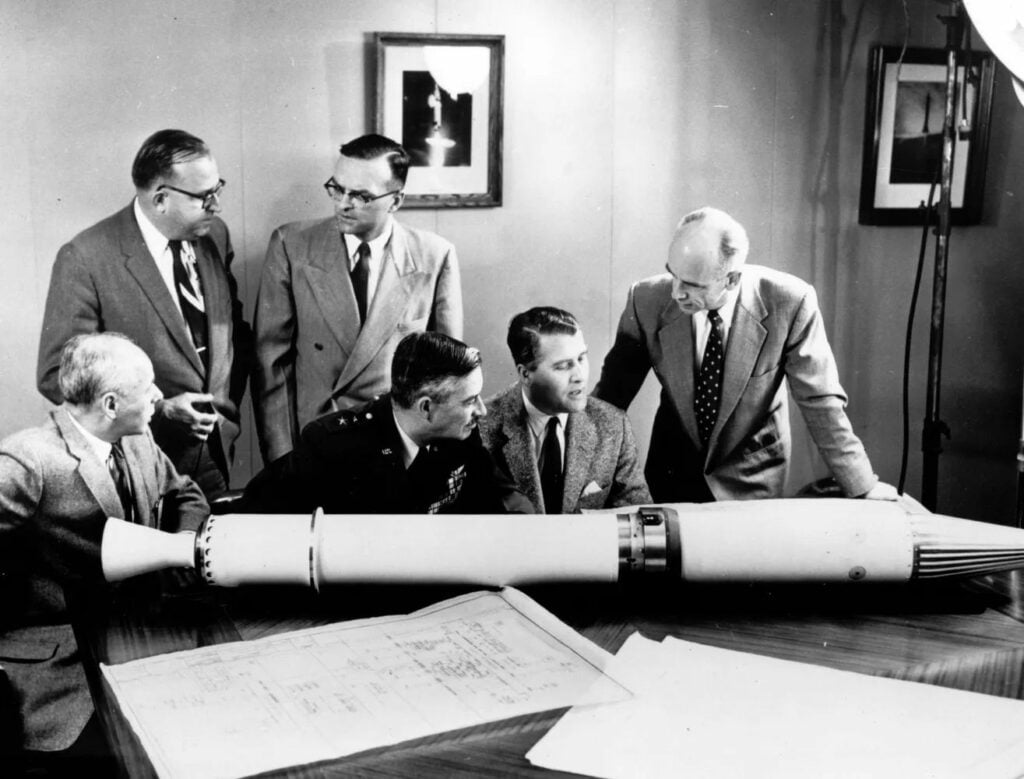
Members of the ABMA satellite team (with Gen. Medaris and Dr. von Braun seated in center) with a model of the Explorer 1 satellite. (Photo, U.S. Army)
Satellites started small. The first U.S. satellite, Explorer 1 — launched in 1958 — weighed only 14 kilograms. But the technology, prized for opening a whole new perspective on our planet, quickly bulked up, enabled by the increasing lifting powers of fast-evolving rockets. Soon, complex satellites the size of a school bus took over, observing the planet from above, broadcasting TV signals across continents and sensing the environment around them.
It was only in the mid-1980s that researchers renewed their interest in smaller satellites with masses of tens to a couple of hundred kilograms. The true small sat revolution, however, began in 1999, with the invention of a cubesat. Based on standardized satellite units of 10 by 10 by 10 centimeters in size, cubesats opened space to anyone with enough technical skill to assemble and operate them. Soon, university teams from all over the world began launching their own experimental spacecraft to provide their students with hands-on space tech experience.
By 2014, San Francisco-based Planet Labs launched its first commercial constellation of 28 three-unit (3U) Earth-observing cubesats called Doves. More than 120 Doves are in orbit today, capturing an image of each place on Earth more than once a day. Other companies followed suit. As of today, cubesats have made it to orbit around Mars and the Moon and observed the impact of NASA’s Double Asteroid Redirection Test (DART) into the asteroid Didymos in 2022 in real-time.
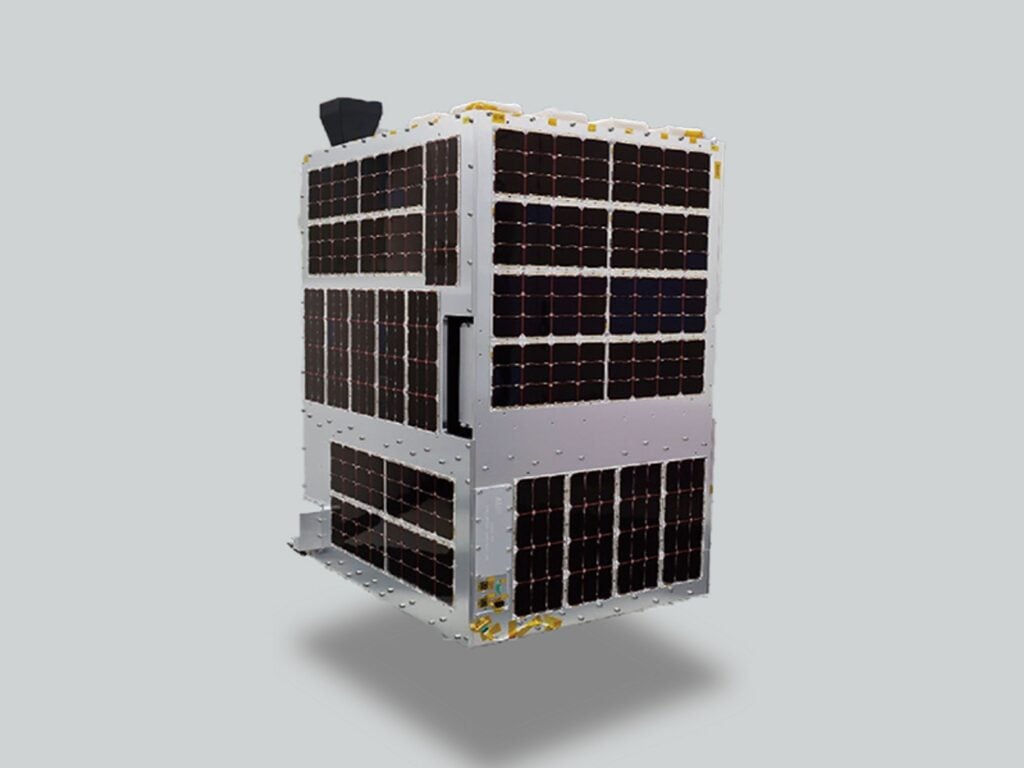
The Axelspace Pyxis mission launched in March of this year. (Photo: Axelspace)
Larger small satellite platforms — up to 500 kg in mass — have also grown in popularity. In fact, these larger small satellites today dominate space around Earth thanks to SpaceX’s constellation of Starlink internet-beaming satellites.
Consulting firm Novaspace predicts that 26,104 small satellites — including minisatellites of 100 to 500 kg in mass, microsatellites between 10 and 100 kg and nanosatellites as light as 1 to 10 kg — will launch in the next decade.
And although the smallsat revolution is already behind us, new technologies are emerging that promise to supercharge the sector in the coming years. Via Satellite spoke with a number of experts in the field about what the smallsat of the future will look like.
Read the full article at: https://interactive.satellitetoday.com/via/august-2024/what-does-the-smallsat-of-the-future-look-like/
[ANS thanks Via Satellite for the above information.]
ASRTU-1 Scheduled for November Launch
Published flight manifests indicate that the Chinese amateur radio satellite ASRTU-1 has been scheduled for launch in November of this year aboard a Russian rocket. As always, launches are subject to a wide variety of variables, and space agencies are not always 100% forthcoming about their activities. So while you may not want to mark the calendar just yet, hopeful signs are pointing toward a launch in the coming months.
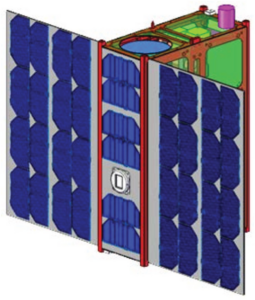
Artist’s sketch of ASRTU-1
ASRTU-1 is a 12U Cubesat mission designed by Russian and Chinese university students for education and amateur radio. Harbin Institute of Technology has successfully developed several amateur radio satellites, including LilacSat-2 (CAS-3H), LilacSat-1 (LO-90), DSLWP-A (LO-93) and DSLWP-B (LO-94). The partner institution is Bauman Moscow State Technical University, which constructed two satellites, Baumanets-1 in 2006 and Baumanets-2 in 2017, both of which unfortunately failed to reach orbit due to launch failures unrelated to the satellite payloads.
The amateur radio station onboard ASRTU-1 will provide FM and telecommand uplinks, as well as FM, telemetry, and digital image downlinks. A new SDR based transceiver was developed to provide communication and experimental resources to radio amateurs, including a V/U FM transponder, a UHF telemetry downlink, and a 10.5G image downlink.
The repeater uplink will be on 145.875 MHz FM using a 67 Hz CTCSS (PL) tone. Downlink will be on 435.400 MHz FM. The telemetry beacon will be on 436.210 MHz using 9k6 bps BPSK.
In addition to the FM repeater, the satellite will also provide an open telecommand system to allow radio amateurs to send commands to control the satellite to take and download images. X Band image downloads using 1 Mbps/10mbps QSPK will downlink on 10.460 GHz.
ASRTU-1 has been scheduled for a Roscosmos launch from Vostochny Cosmodrome, Asiatic Russia, in Q4 2024 into a 530 km Sun-synchronous Orbit (SSO). Downlinks and the repeater uplink have been coordinated by the International Amateur Radio Union (IARU).
[ANS thanks IARU and x.com/AKAhamradio/ for the above information.]
Want to fly the colors on your own grid expedition?
Get your AMSAT car flag and other neat stuff from our Zazzle store!
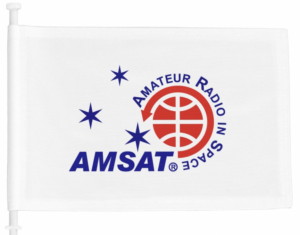
25% of the purchase price of each product goes towards
Keeping Amateur Radio in Space
https://www.zazzle.com/amsat_gear
Changes to AMSAT-NA TLE Distribution for August 2
Two Line Elements or TLEs, often referred to as Keplerian elements or keps in the amateur community, are the inputs to the SGP4 standard mathematical model of spacecraft orbits used by most amateur tracking programs. Weekly updates are completely adequate for most amateur satellites. TLE bulletin files are updated daily in the first hour of the UTC day. New bulletin files will be posted immediately after reliable elements become available for new amateur satellites. More information may be found at https://www.amsat.org/keplerian-elements-resources/.
{This spot for changes to TLEs when applicable. Can be eliminated or replaced if none.}
{Do note that our Manual of Style specifies that we ALWAYS use first & last names, callsign separated by commas, and then the title of the AMSAT officer, if any. See example below. Same style applies to persons referenced in story bodies, as well as in attributions.}
[ANS thanks Joe Fitzgerald, KM1P, AMSAT Orbital Elements Manager for the above information]
ARISS NEWS
Amateurs and others around the world may listen in on contacts between amateurs operating in schools and allowing students to interact with astronauts and cosmonauts aboard the International Space Station. The downlink frequency on which to listen is 145.800 MHz worldwide.
COMPLETED:
Kopernik Observatory, Vestal, NY, direct via K2ZRO
The ISS callsign was NA1SS
The scheduled crewmember was Matthew Dominick KCØTOR. The ARISS mentor was AB1OC
Contact was successful: Wed 2024-07-31 18:17:25 UTC 43 degrees maximum elevation.
Congratulations to the Kopernik Observatory students, Matthew, mentor AB1OC, and ground station K2ZRO!
Watch for Livestream at https://youtube.com/live/Tv3x3D0DTzU?feature=share
SMPIT Nurul Ishlah, Banda Aceh, Indonesia, telebridge via VK4ISS
The ISS callsign was scheduled to be NA1SS
The scheduled crewmember was Sunita Williams KD5PLB. The ARISS mentor was VE3TBD
Contact was go for: Fri 2024-08-02 12:43:07 UTC 27 deg
Aznakaevsky district of the Republic of Tatarstan, Russia, direct via TBD
The ISS callsign was scheduled to be RSØISS
The scheduled crewmember was Nikolay Chub. The ARISS mentor was RV3DR
Contact was go for Sat 2024-08-03 14:40 UTC
UPCOMING:
International Astronomical Union (IAU) General Assembly 2024, Cape Town, South Africa, telebridge via VK6MJ
The ISS callsign is presently scheduled to be NA1SS
The scheduled crewmember is Sunita Williams, KD5PLB, Jeanette Epps, KF5QNU, Matthew Dominick, KCØTOR, or Mike Barratt, KD5MIJ. The ARISS mentor is KA3HDO
Contact is go for: Fri 2024-08-09 11:55:06 UTC 40 deg
Watch for Livestream at https://astronomy2024.org/
A.G. Nikolaev Secondary School, Shorshel, Chuvashia, Russia direct via TBD
The ISS callsign is presently scheduled to be RSØISS
The scheduled crewmember is Nikolay Chub. The ARISS mentor is RV3DR
Contact is go for Sun 2024-08-11 08:20 UTC
The crossband repeater continues to be active (145.990 MHz up {PL 67} & 437.800 MHz down). If any crewmember is so inclined, all they have to do is pick up the microphone, raise the volume up, and talk on the crossband repeater. So give a listen, you just never know.
The packet system is also active (145.825 MHz up & down).
As always, if there is an EVA, a docking, or an undocking; the ARISS radios are turned off as part of the safety protocol.
Note, all times are approximate. It is recommended that you do your own orbital prediction or start listening about 10 minutes before the listed time.
The latest information on the operation mode can be found at https://www.ariss.org/current-status-of-iss-stations.html
The latest list of frequencies in use can be found at https://www.ariss.org/contact-the-iss.html
[ANS thanks Charlie Sufana, AJ9N, one of the ARISS operation team mentors for the above information]
Upcoming Satellite Operations
+ N8MR will be in EN57, with roves to EN67 from Friday, August 2 thru Saturday, August 10. Using an Icom 9700, Arrow and Alaskan antennas. Listening for Europe on linear eastern passes, with at least two of these passes being on CW. Can operate CW for NA ops, if anyone wants it. I can rove to EN56, only if needed. Posting passes to http://hams.at a day in advance. All QSOs to LoTW as N8MR.
+ Posted July 23rd by @SeanKutzko KX9X, on X (formerly Twitter): A reminder that I’m leaving for Hawaii this Friday! Will be on SSB / FM sats *holiday style* plus maybe some QRP FT8. No GreenCube, sorry. Will post passes here and to https://hams.at soon. #HamRadio @AMSAT #AMSAT
+ Posted July 21st by @W8LR_Jerry, on X (formerly Twitter): EM57/58 and EM67/68 are still planned for Aug 2/3. Please check http://hams.at and @W8LR_Jerry for updates. As I mentioned two months ago EM85 in TN will now be in my travel schedule beginning in Sept. I was just notified today. I will be doing FM/Linear/GC when there. More later.
+ Posted July 25th by @AD0HJ, on X (formerly Twitter): Work trip coming up the first full week of August in Fort Collins, Colorado. Will make stops on the EN02/EN03 | DN82/DN92 grid lines on the drive out. DN90/DN91 | EN20/EN30 grid lines on the way back. RS-44 satellite passes in the evenings. Posted at http://hams.at.
+ Jonathan @N4AKV_ has posted an ambitious August roving schedule on his qrz.com page. Tentative plans for a major satellite and 6m road trip through Maine, Nova Scotia, Newfoundland, and St. Pierre and Miquelon this summer. Satellite passes listed on https://hams.at for the next week include grid squares FN43, FN53, and GN16.
+ FP/N4AKV will be on IO-117 on August 8. See https://hams.at for details.
A growing number of satellite rovers are currently engaged in sharing their grid square activations on https://hams.at. By visiting the website, you gain easy access to comprehensive information about the operators responsible for activating specific grid squares. Additionally, you have the ability to assess the match score between yourself and a particular rover for a given pass, while also being able to identify the upcoming satellite passes that are accessible from your location.
[ANS thanks Ian Parsons, K5ZM, AMSAT rover page manager, for the above information]
AMSAT Ambassador Activities
AMSAT Ambassadors provide presentations, demonstrate communicating through amateur satellites, and host information tables at club meetings, hamfests, conventions, maker faires, and other events.
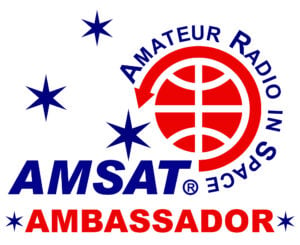
August 17-18, 2024
Huntsville Hamfest
Huntsville, AL
AMSAT Booth and Forum
N8DEU and W4FCL
September 7, 2024
Greater Louisville Hamfest
Shepherdsville, KY
AMSAT Forum and Information Table
W4FCL
October 5, 2024
Central Kentucky Hamfest
Lexington, KY
AMSAT and Educational Satellites Forum and Information Table
AI4SR and W4FCL
October 5, 2024
North Star Radio Convention
Hennepin Technical College (North Campus)
Brooklyn Park, Minn.
AMSAT Forum and Information Table
KØJM and ADØHJ
October 25-27, 2004
AMSAT Space Symposium and Annual General Meeting
Double Tree Rocky Point Waterfront Hotel
Tampa Bay, FL
November 2-3, 2024
Stone Mountain Hamfest, ARRL State Convention
Stone Mountain, GA
K4RGK
Interested in becoming an AMSAT Ambassador? AMSAT Ambassadors provide presentations, demonstrate communicating through amateur satellites, and host information tables at club meetings, hamfests, conventions, maker faires, and other events.
For more information go to: https://www.amsat.org/ambassador/
[ANS thanks the AMSAT Events page for the above information]
Satellite Shorts From All Over
+ The MESAT-1 team are continuing to test and commission the satellite. It is currently in Health Mode transmitting continuously and the downlink power is now about 6dB higher. So it should be easier to hear and decode. If you have had trouble decoding it then now is a good time to try again. Software may be downloaded from https://www.amsat.org/foxtelem-software-for-windows-mac-linux/ (ANS thanks Chris E. Thompson, VE2TCP / G0KLA / AC2CZ, for the above information.)
+ SpaceX is now targeting mid- to late August for the launch of Polaris Dawn, a mission funded by billionaire entrepreneur Jared Isaacman. The upcoming flight, which will employ SpaceX’s Crew Dragon spacecraft and Falcon 9 rocket, had been slated to lift off no earlier than July 31. SpaceX announced the delay today (July 26), during a press conference focusing on the company’s upcoming Crew-9 astronaut mission to the International Space Station (ISS) for NASA. The NASA mission will include Zena Cardman, KJ5CMN, Nick Hague, KG5TMV, Stephanie Wilson, KD5DZE, and Aleksandr Gorbunov, Roscosmos. Crew-9 will launch no earlier than Aug. 18, and Polaris Dawn will fly sometime after that, the company said. The Polaris Dawn mission is scheduled to include the first-ever private spacewalk. (ANS thanks Space.com for the above information.)
+ The U.S. military is installing modular state-of-the-art satellite jammers capable of disrupting Russian or Chinese communications, should the need arise. Even though the hardware is ground-based, the U.S. Space Force will oversee installation and operation. The technology is already past prototyping. The military tested the system at two different locations earlier this year. The Department of Defense allocated funds to build 24 remote installations, with 11 scheduled to deploy before the end of the year. (ANS thanks SatNews.com for the above information.)
+ SpaceX Falcon 9 returned to flight with three Starlink launches in 30 hours after only 15 days of being grounded due to its recent upper-stage anomaly (a brittle, and presumably cracked, pressure monitoring line) and conducted its 300th reflight of a booster. (ANS thanks The Orbital Index for the above information.)
+ Boeing performed a hot fire test of the 27 maneuvering thrusters aboard the docked Starliner space capsule, which could be the last test before the spacecraft’s delayed return to Earth is approved. Astronauts Barry “Butch” Wilmore, and Sunita Williams, KD5PLB, took Starliner to the International Space Station on June 5 for what was to have been a 10-day test flight. NASA says they may now return in late August. (ANS thanks The Orbital Index for the above information.)
Join AMSAT today at https://launch.amsat.org/
In addition to regular membership, AMSAT offers membership to:
* Societies (a recognized group, clubs or organization).
* Primary and secondary school students are eligible for membership at one-half the standard yearly rate.
* Post-secondary school students enrolled in at least half time status shall be eligible for the student rate for a maximum of 6 post-secondary years in this status.
* Memberships are available for annual and lifetime terms.
Contact info [at] amsat.org for additional membership information.
73 and remember to help Keep Amateur Radio in Space!
This week’s ANS Editor, Mark Johns, KØJM
mjohns [at] amsat.org
